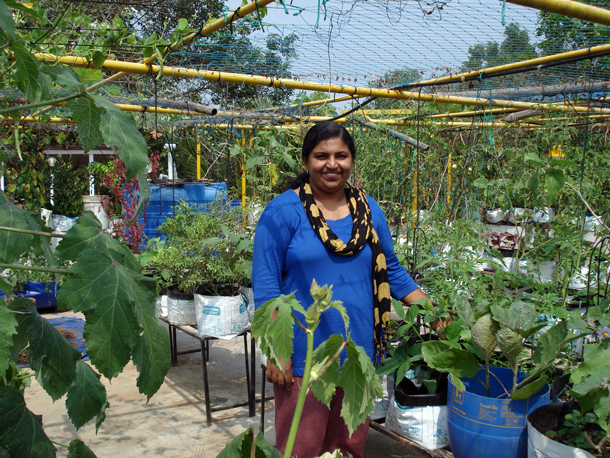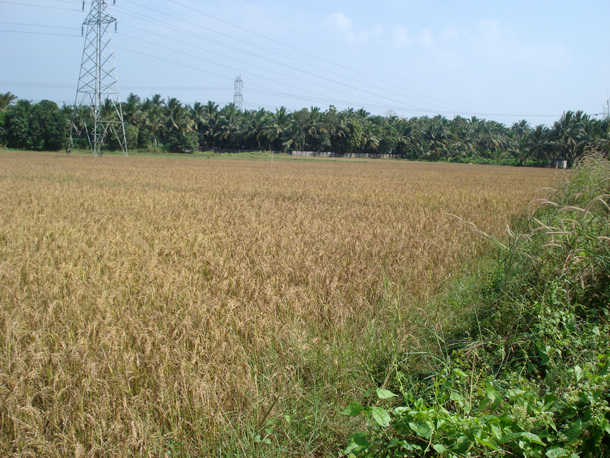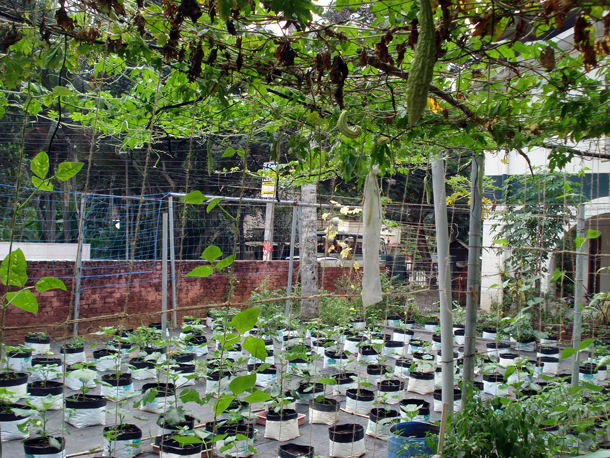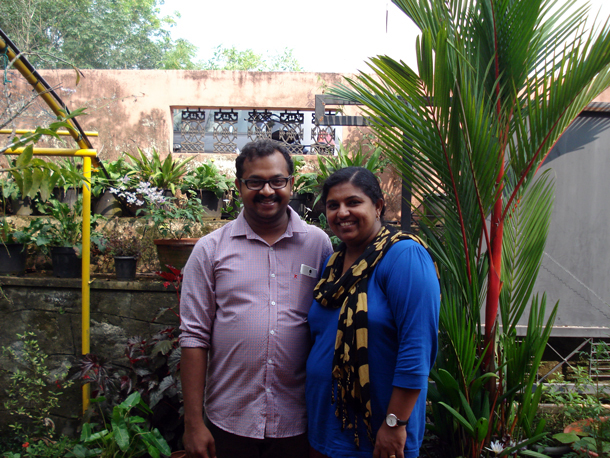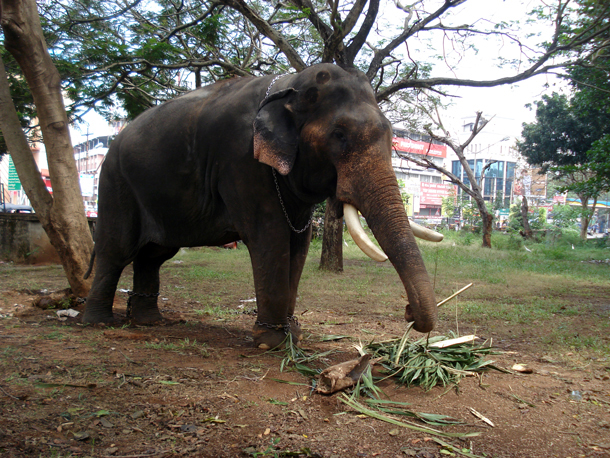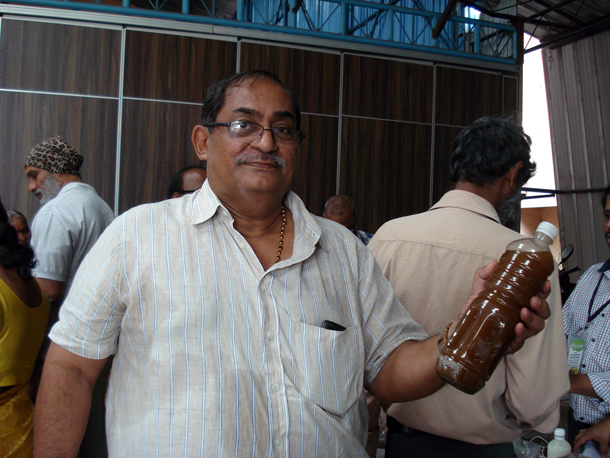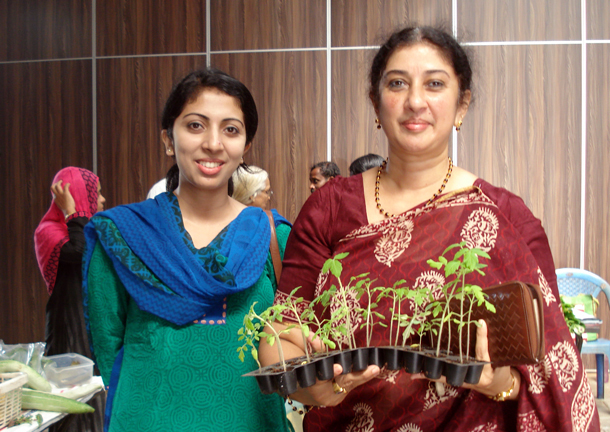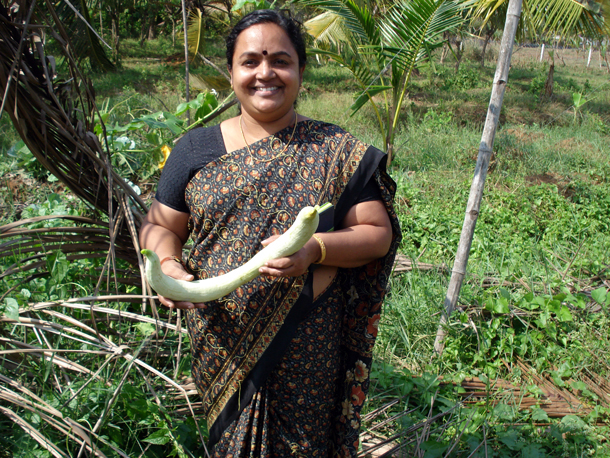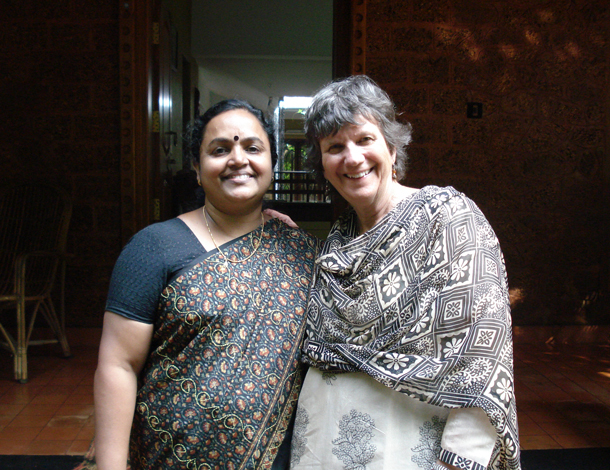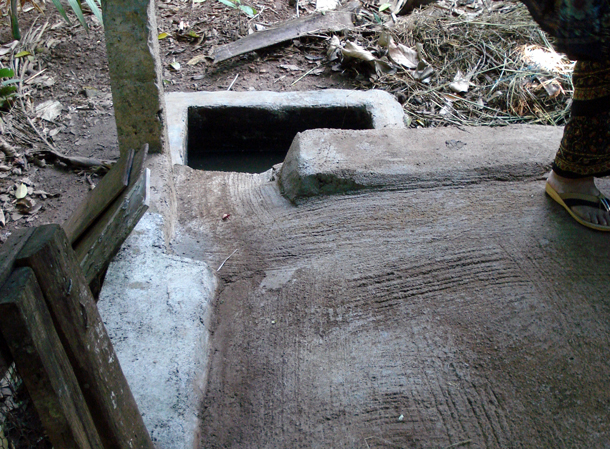Pesticide Peril in Paradise
Air Date: Week of May 11, 2018
This week, we return to Kerala, India, to learn more about why that state’s food supply is going organic and how that ambitious target can be achieved. Part of the success will depend on Keralans who have taken up organic gardening as a hobby, or even a second career. They tend to their rooftop gardens, care for their backyard livestock, and sell extra produce at large organic markets where their healthy chemical free food sells for premium prices. Living on Earth’s Helen Palmer has the story.
Transcript
CURWOOD: It’s Living on Earth, I’m Steve Curwood. Kerala state in South India has a lush tropical climate, with bananas, and coconuts lining the roads, and spices growing in the shade of bountiful papaya and guava trees. So one might think there is plenty of organic food in Kerala, given the ease of growing, as well as the perception of its educated population that troubling cancer rates are tied to chemical farming.
But Keralans prefer white collar jobs in the Middle East to tilling the soil at home, so fields lie fallow and food with pesticide residues is imported. Now that’s changing as the state government has developed plans to take Kerala’s agriculture 100% organic by 2020. And already many urban dwellers are taking up organic gardening on their rooftops with enthusiasm and passion. Living on Earth’s Helen Palmer has our story.
[TINNY MUSIC PLAYING IN TAXI]
PALMER: To see what organic home gardening means in practice in Kerala, I took a bumpy taxi down dusty pot-holed lanes to the outskirts of the capital Trivandrum to meet Sujitha Sudhakaran…
[CAR DOOR SLAMS, TAXI IDLING, MUSIC CONTINUES]
SUDHAKARAN: Hi Helen!
PALMER: Hi Sujitha, thank you for coming to meet me!
SUDHAKARAN: Oh, it’s so nice to meet you!
PALMER: So great to meet you!
PALMER: Sujitha’s medium height and plump, with laughing black eyes and a royal blue blouse over maroon pants. She and her husband Manu live in a tidy square house set back from the road amid a riot of green – flanked by fruit trees with dozens of pots full of plants and waterlilies crowding the front courtyard ….
SUDHAKARAN: Actually I have almost 27 varieties of waterlilies here and mainly these are tropical varieties which blooms a lot, and all the dragonflies and butterflies, honey bees, all these get attracted to these water bodies and my pollination in my vegetable garden is taken care by these flies and bees.
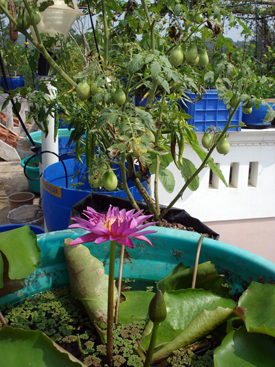
Water lilies attract bees and dragonflies that help fertilize Sujitha’s tomatoes and chilies. (Photo: Helen Palmer)
PALMER: And that looks like a grape vine growing over the trellis on the top here?
SUDHAKARAN: Yes, yes, it’s a grape-vine, I planted it one year back and I’m expecting fruits this year. Because the grapes that we get here is almost full of pesticides. They spray a lot of pesticides in order to get the fruits, so I thought OK at least one bunch I can eat without pesticide.
[SUJITHA LAUGHS]
PALMER: Pesticides. That’s the problem Sujitha and thousands of other concerned Keralans are trying to solve by going organic. Both doctors and the public believe chemicals lurking in food share a large part of the blame for high levels of cancer in Kerala, and that’s led the state government to call for a totally organic agricultural sector by 2020. One group of Keralans in particular has taken up gardening without pesticides or chemical fertilizers with special zeal -- educated professionals. Take this retired bank executive – who lives on a busy street behind a sturdy metal gate in a fashionable Trivandrum suburb.
[SOUNDS OF TRAFFIC, GATE CLANGING, AND WORKMEN BANGING]
KRISHNAN: I’m Unni Krishnan. I was designated the agriculture officer, financing farmers and agriculturalists, and that was a turning point in mid-life.
PALMER: Unni Krishnan is tall, earnest and white haired. That turning point working with farmers made him retire from his safe, comfortable job at the State Bank of Travancore 12 years early to grow his own food, and to teach other people how to do the same. He says he’s inspired hundreds….
KRISHNAN: Around 400, to 500 people I have inspired, you know.
PALMER: Really?
KRISHNAN: Yes sure, through Facebook also, people get inspired.
PALMER: In the large garden he has behind the gate, neat rows of dozens of pots of chiles, okra, eggplant, amaranth and cabbages spill over from the garden to the patio. On his three roof terraces, gourds and tomatoes hang from the tall shade trellis he built with hemp rope and bamboo. On a wall, scarlet chili peppers sit on a plate drying in the sun. Unni says he has to water his many pots and bags twice a day and it takes hours, but that’s OK, it’s his passion.
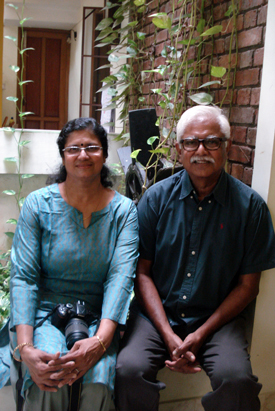
Unni Krishnan (right) and wife Latha (left) have three large roof terraces. Unni used to work at the state Bank of Travancore, but retired early to grow his own organic food and inspire other Keralans to do the same. (Photo: Helen Palmer)
KRISHNAN: My work is my hobby, it’s a kind of meditation for me. I don’t identify outside world when I do this work.
PALMER: His garden is a calm oasis on a busy street, with high brick walls surrounded by tall coconut palms. He shows me the potting mix he prepares and hands out with grow bags.
KRISHNAN: This is potting mix I give. Potting mix, it is a combination of soil, then peat, then organic fertilizer also.
PALMER: How is the soil in Kerala?
KRISHNAN: Actually it’s a bit acidic in Kerala, so probably you can use that lime to make it alkaline.
PALMER: The poor soil he points to is not a problem for home gardeners like Unni Krishnan who takes feeding the soil very seriously and can easily afford that lime. At her home, Sujitha Sudhakaran has her own whole complex system set up outside her kitchen, where workmen are installing a new cupboard for her.
SUDHAKARAN: For my plants which are on the top, I make compost. I make vermicompost and I make bokashi composting.
PALMER: So Bokashi is what? It’s not a word I know.
SUDHAKARAN: Actually it’s a Japanese word which means ‘ferment, to ferment’, and it’s a technology wherein we add micronutrients directly to the compost so that the decaying process fastens. So I get almost all the compost which is required for my plants from my home, so I don’t buy it from outside.
PALMER: She points to her dozens of buckets – old industrial containers salvaged from the scrap heap.
SUDHAKARAN: This is mainly my composting area.
PALMER: Oh I see you’ve got many many big containers, these are all full of compost?
SUDHAKARAN. Compost – one will be full of cow dung, one will be with another type of compost, one will be with coffee grounds and egg shells, and this one is like rice water, starch which I use as a pesticide, this is a biogas plant…
[WORKMEN BANGING]
… wherein I can put all the waste into it and the biogas slurry will be collected at the other end, which I can use as a fertilizer for my plants.
PALMER: So they collect the biogas and use the biogas, and what’s left you can use as fertilizer?
SUDHAKARAN: Yes, the gas I can use for cooking and the slurry, the left over, that I can use for my plants.
PALMER: Gosh, so what goes into the biogas plant?
SUDHAKARAN: All the waste, I mean kitchen waste, we can put fish waste, chicken waste, not the bones, but the other meat part, we can put in there, left over rice we can put in there – except lemon we cannot put that – onion peels, we cannot put that also, so all the other things, it goes into that.
PALMER: Wow! And it generates biogas for you?
SUDHAKARAN: Yes for cooking, and at the same time the slurry is collected.
PALMER: That’s extraordinary that somebody does that on a home level.
SUDHAKARAN: [LAUGHS] Yeah.
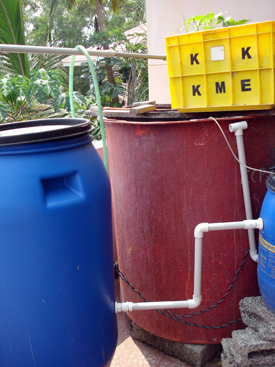
Sujitha built her own hydroponic system on her roof terrace, and uses the fish waste as fertilizer. (Photo: Helen Palmer)
[SOUNDS OF CLIMBING STAIRS, OUTSIDE SOUNDS, DISTANT TRAFFIC]
PALMER: And Sujitha is extraordinary – we climb up to her roof terrace where she keeps an aquaponic system and grows rice….
SUDHAKARAN: There are fishes inside this – this tank…
PALMER: Oh I see! what kind of fishes? They look like goldfish.
SUDHAKARAN: This is spotted fish, and there is another one, tilapia. I harvested, I planted a paddy, but I harvested and now it’s not there, this is a second crop –this is a kind of spinach, these are chili plants, I pruned it, and these are cow peas.
PALMER: I’m astonished by how much she can grow in her bags and pots – they’re just pots, they’re not garden beds. Sujitha’s husband, Manu, tells me she grew enough food for a feast for their whole extended family at India’s Thanksgiving, the late summer harvest festival Onam.
MANU: Last Onam, we decided to call all our family here and we all joined and we made food out of what we’d grown from our terrace, so completely it was from our terrace.
PALMER: So what did you actually eat?
MANU: We made – we call it sadya – we’ll have boiled rice, there would be something called avil, which is made out of 4 different vegetables, we use a lot of vegetables, and then there would be a curry that is called a sambah, which is made out of, again vegetables, so it would be a complete vegetarian feast. So including the rice, everything required for that was grown here, in our terrace!
PALMER: The bounty of food from organic home gardeners like Sujitha has helped launch another Kerala innovation – organic markets.
[BUSY TRAFFIC]
On Saturdays, small farmers and rooftop cultivators bring their spare produce to the Centenary Indoor Stadium. It’s a large shed in the heart of Kerala’s cultural capital, Thrissur, about 180 miles north of Trivandrum.
[NOISY TRAFFIC, ECHOEY MARKET SOUNDS, CHATTER]
Outside the stadium, incessant traffic circles a large park where a solemn elephant tethered under large trees munches on palm fronds; inside, trestle tables are piled high with bananas and squash, spinach, tamarind, bottles of coconut oil, yams, papaya and spiky young jack fruit. The place is packed, and I’m instantly cornered by a large man.
JOSEPH: My name is not that difficult, it’s Paul Joseph.
PALMER: He tells me he’s at the market as a buyer and a seller.
JOSEPH: I have an orchard where I have most of the things, like most of the vegetables and fruits. I have different varieties of papaya, the Red Lady and one variety from US also I have – and I do have a lot of naranjas, you know, citrus fruits.
PALMER: Aha – so oranges?
JOSEPH: Not oranges, oranges are not grown in this part, limes, different types of limes.
PALMER: Limes? Okay.
JOSEPH: And leafy vegetables, plenty leafy vegetables.
PALMER: Paul Joseph retired after 28 years as a chief engineer in the merchant marine, and he’s an enthusiastic guide to the market, identifying unfamiliar looking vegetables.
PALMER: What is that?
JOSEPH: Spinach, that’s a different kind of spinach.
PALMER: Aha – what are those things beside it?
JOSEPH: That one is – you know the banana tree?
PALMER: Yeah.
JOSEPH: It’s the stem of the banana tree.
PALMER: The stem of the banana tree?
JOSEPH: They say that it’s very good for diabetes and all those things. And the next one is noni.
PALMER: Noni?
JOSEPH: It’s an anti-oxidant, they say that it’s very good for cancer, it’s a Brazilian fruit.
PALMER: It’s a fruit?
JOSEPH: It’s a fruit. The next one is a yam. –
PALMER: A yam, OK.
JOSEPH: There are 2 different interesting things – this is the urine of the cow – it’s used in two ways. One, this is used as pesticide, and also as medicine.
PALMER: As medicine?
JOSEPH: Yeah.
PALMER: People take it? People drink it?–
JOSEPH: How do they use it I have no idea.
SANOJ: It is a general health tonic –
PALMER: Say again?
SANOJ: General health tonic.
PALMER: People drink it?
SANOJ: Yes, drink it – do you want to taste it? Want to taste it? –
PALMER: NO! [LAUGHS]
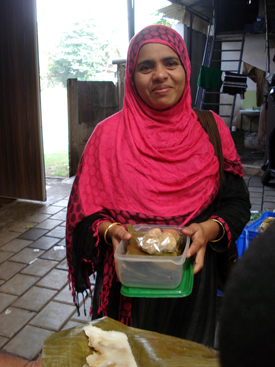
Sheba made a popular snack of rice flour and coconut sugar, steamed in a banana leaf, that’s known as Adha. (Photo: Helen Palmer)
PALMER: Cows, of course, are sacred in Hindu India, and though about 20% of Kerala’s population are Catholics like Paul Joseph, cow manure and urine are still put to many uses.
There are good things to eat at the market too – as well as selling spinach and curry leaf, Sheba, a home maker in a brilliant fuschia headscarf, has prepared adha, a popular sweet snack of rice flour, grated coconut and jaggery, raw coconut sugar wrapped in a banana leaf.
SHEBA: This making rice powder and including certain sweets.
PALMER: And you cook it in a banana leaf?
SHEBA: Banana leaf.
PALMER: And you boil it?
SHEBA. Steaming, steam.
PALMER: Steam…
SHEBA: Yes.
PALMER: – It’s very sweet, but actually quite delicious. Among the farmers are retired doctors, and university professors, and business people. Another home maker, Seena Mohan, dressed in a stylish sari and married to the owner of two movie theaters, is there buying organic tomato seedlings with her daughter Sapna, an eye doctor who explains her mother’s plans.
SAPNA MOHAN: We have an empty space – so she likes to do a bit of farming, actually for vegetables which are pure - even she’s planning to buy a cow!
PALMER: Really? What do you think about this?
SAPNA MOHAN: I don’t know, I have no time to look after, she is more interested, so let her try.
PALMER: Why do you want to do this?
SEENA MOHAN. Because we are hearing about this poison and everything in our foods – even we are importing these foods from other countries – I am starting cultivating fruits and vegetables, different type, just starting.
PALMER: So tomatoes – what else will you grow?
SEENA MOHAN: Tapioca, yeah, tapioca, then tomato, the chili, then coconuts, then banana, lot of fruits, mangosteen, rambutan, different types of mangos, different types of Jack fruits - I planted, I think I planted 60 numbers of fruits trees plants.
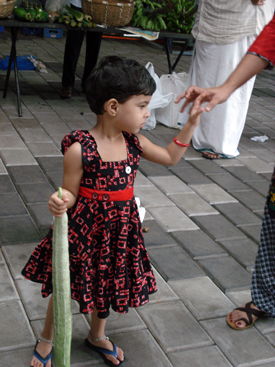
The snake gourd is a popular Keralan vegetable, even among children. (Photo: Helen Palmer)
PALMER: I’m struck by the easy relationships in the market – growers and customers like Seena, who’s Hindu, Sheba, a Muslim, and Paul Joseph, who is Catholic, are united by their common passion for growing and spreading the gospel of healthy organic food. I meet one of the market organizers, Sandhya Kumar, who’s infectiously cheerful and energetic – and like so many, has taken on a second career as an organic gardener.
KUMAR: Last 24 years I was working as a teacher in our area schools, then became passionate towards agriculture, I resigned the job, and I’m doing agriculture now, last 2 years, I started agriculture – and I’m fully organic.
PALMER: On her fully organic acre of land, Sandhya grows the now familiar staples -- coconuts, bananas, eggplants, nutmeg, pepper -- but she also has hens, goats, a cow and a down-to-earth, very business-like approach.
KUMAR: So with that cow I am making ghee and paneer also, as value added products.
PALMER: So ghee is clarified butter, I know and paneer is cheese.
KUMAR: Hmm, with the hibiscus flower I will make squash, like that.
PALMER: So you make hibiscus flower squash?
KUMAR: [LAUGHS] Then brinjal – I will make pickles.
PALMER: Ah – pickled eggplant.
KUMAR: And virgin coconut oil also I am making, with our own coconut, with that I am making virgin coconut oil. Plenty of people are waiting for these organic products so no problem at all selling. [LAUGHS]
PALMER: That is very good!
KUMAR: Milk also I am selling!
PALMER: The milk from the cow?
KUMAR: Goat, goat milk also.
PALMER: Goat?
KUMAR: 100 rupees per liter the milk – normally here, one liter ordinary cow’s milk will cost 40 rupees, now goat milk costs 100 Rupees, that’s the difference.
[TRAFFIC SOUNDS FADE, BIRDS AND GARDEN SOUNDS]
PALMER: Sandhya invites me to her farm – she lives in a large cool house shaded by coconut palms and jack fruit trees at the end of a long drive.
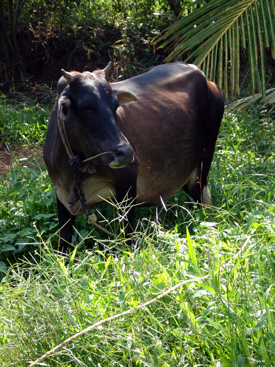
Sandhya’s acre of land is also home to hens, goats, and a cow as well as her organic garden. (Photo: Helen Palmer)
[DOG BARKS]
KUMAR: My husband.
PALMER: Pleased to meet you.
AJIT KUMAR: Hello.
KUMAR: So this is our home.
PALMER: And your name is, Sir…?
AJIT KUMAR: Ajit.
PALMER: Ajit?
KUMAR: Don’t ask anything about agriculture, organic, he will not know anything about that!
PALMER: He is a businessman you say.
[SANDHYA LAUGHS]
PALMER: Business man. But you support your wife?
AJIT KUMAR: Supporting. Fund is mine, all funding is mine!
[AJIT AND SANDYA BOTH LAUGH]
PALMER: Ajit runs a successful chain of coffee shops that employ people with disabilities.
[BIRDS, WALKING THROUGH DRY LEAVES]
Sujitha leads the way out to the wide green garden behind the house. There are coconut palms, bread fruit, dozens of banana and mango trees and in their shade, she plants spices.
KUMAR: This year I planted the ginger.
PALMER: That is ginger?
KUMAR: Ah, it’s ginger. Ginger last year in our market, 10 Kgs, I sold out, 100 Rupees per Kg.
PALMER: 100 Rupees per kilogram?
KUMAR: Non-organic, 60 Rupees per kilogram –
PALMER: But organic 100.
[GOATS BLEATING, WALKING THROUGH DRY LEAVES, BIRDS]
PALMER: We thread our way through her lush jungle of fruit trees and spice bushes, their roots kept cool by palm fronds and dead leaves as mulch. We pass the goat pen -
[GOATS BLEATING]
- and reach the bank of a small irrigation ditch where her dark brown cow is grazing. Her name is Muta, which means Pearl. Around her banana trees Sandhya has spread the goats’ droppings – and she says the cow and her calf give useful products beyond milk. We walk to her cowshed – basically just a roof of interlaced palm fronds over a concrete floor that slopes down to a shallow tank in one corner.
KUMAR: In this tank we will collect urine. These 2 buckets, every weekly once, I made that organic manure with the cow dung, cow urine, then jaggery, then soil.
PALMER: Jaggery is concentrated raw sugar made from coconut palms. Sandhya says that manure not only fertilizes her plants but has transformed her soil since she started her organic garden two years ago.
KUMAR: Every year I can feel the change in this soil. Just two years before, I felt this soil as dead. Now I can feel it just smart like me, the soil!
[SANDYA LAUGHS]
PALMER: It’s full of earthworms and leaf mold now, she says. As we head back to her house, Sandhya confides….
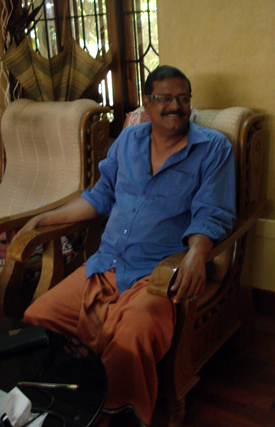
Sandhya refers to her husband Ajit (above) as “elephant lazy,” since he likes to sit and watch TV. But he pays for whatever she wants for her organic farm. (Photo: Helen Palmer)
KUMAR: My husband is elephant lazy – like that way I call you understand what’s that? Very lazy, that much lazy. 24 hours he will sit like this, watching TV or doing something. Then whatever I ask, he will give – money – no inquiry, no interventions, nothing.
PALMER: It sounds like a perfect marriage!
[SANDYA LAUGHS]
PALMER: Sandhya and Ajit and the investment of labor and cash they’re prepared to make are typical of Kerala’s middle-class backyard and rooftop gardeners. And they’re part of the state government’s calculation for how it can reach its ambitious Green Kerala goals – 100% organic food by 2020 -- at least as far as vegetables are concerned.
For Living on Earth, I’m Helen Palmer in Kerala, India.
[BIRDSONG]
Links
Living on Earth wants to hear from you!
Living on Earth
62 Calef Highway, Suite 212
Lee, NH 03861
Telephone: 617-287-4121
E-mail: comments@loe.org
Newsletter [Click here]
Donate to Living on Earth!
Living on Earth is an independent media program and relies entirely on contributions from listeners and institutions supporting public service. Please donate now to preserve an independent environmental voice.
NewsletterLiving on Earth offers a weekly delivery of the show's rundown to your mailbox. Sign up for our newsletter today!
 Sailors For The Sea: Be the change you want to sea.
Sailors For The Sea: Be the change you want to sea.
 The Grantham Foundation for the Protection of the Environment: Committed to protecting and improving the health of the global environment.
The Grantham Foundation for the Protection of the Environment: Committed to protecting and improving the health of the global environment.
 Contribute to Living on Earth and receive, as our gift to you, an archival print of one of Mark Seth Lender's extraordinary wildlife photographs. Follow the link to see Mark's current collection of photographs.
Contribute to Living on Earth and receive, as our gift to you, an archival print of one of Mark Seth Lender's extraordinary wildlife photographs. Follow the link to see Mark's current collection of photographs.
 Buy a signed copy of Mark Seth Lender's book Smeagull the Seagull & support Living on Earth
Buy a signed copy of Mark Seth Lender's book Smeagull the Seagull & support Living on Earth
This week, we return to Kerala, India, to learn more about why that state’s food supply is going organic and how that ambitious target can be achieved. Part of the success will depend on Keralans who have taken up organic gardening as a hobby, or even a second career. They tend to their rooftop gardens, care for their backyard livestock, and sell extra produce at large organic markets where their healthy chemical free food sells for premium prices. Living on Earth’s Helen Palmer has the story.
Transcript
CURWOOD: It’s Living on Earth, I’m Steve Curwood. Kerala state in South India has a lush tropical climate, with bananas, and coconuts lining the roads, and spices growing in the shade of bountiful papaya and guava trees. So one might think there is plenty of organic food in Kerala, given the ease of growing, as well as the perception of its educated population that troubling cancer rates are tied to chemical farming.
But Keralans prefer white collar jobs in the Middle East to tilling the soil at home, so fields lie fallow and food with pesticide residues is imported. Now that’s changing as the state government has developed plans to take Kerala’s agriculture 100% organic by 2020. And already many urban dwellers are taking up organic gardening on their rooftops with enthusiasm and passion. Living on Earth’s Helen Palmer has our story.
[TINNY MUSIC PLAYING IN TAXI]
PALMER: To see what organic home gardening means in practice in Kerala, I took a bumpy taxi down dusty pot-holed lanes to the outskirts of the capital Trivandrum to meet Sujitha Sudhakaran…
[CAR DOOR SLAMS, TAXI IDLING, MUSIC CONTINUES]
SUDHAKARAN: Hi Helen!
PALMER: Hi Sujitha, thank you for coming to meet me!
SUDHAKARAN: Oh, it’s so nice to meet you!
PALMER: So great to meet you!
PALMER: Sujitha’s medium height and plump, with laughing black eyes and a royal blue blouse over maroon pants. She and her husband Manu live in a tidy square house set back from the road amid a riot of green – flanked by fruit trees with dozens of pots full of plants and waterlilies crowding the front courtyard ….
SUDHAKARAN: Actually I have almost 27 varieties of waterlilies here and mainly these are tropical varieties which blooms a lot, and all the dragonflies and butterflies, honey bees, all these get attracted to these water bodies and my pollination in my vegetable garden is taken care by these flies and bees.

Water lilies attract bees and dragonflies that help fertilize Sujitha’s tomatoes and chilies. (Photo: Helen Palmer)
PALMER: And that looks like a grape vine growing over the trellis on the top here?
SUDHAKARAN: Yes, yes, it’s a grape-vine, I planted it one year back and I’m expecting fruits this year. Because the grapes that we get here is almost full of pesticides. They spray a lot of pesticides in order to get the fruits, so I thought OK at least one bunch I can eat without pesticide.
[SUJITHA LAUGHS]
PALMER: Pesticides. That’s the problem Sujitha and thousands of other concerned Keralans are trying to solve by going organic. Both doctors and the public believe chemicals lurking in food share a large part of the blame for high levels of cancer in Kerala, and that’s led the state government to call for a totally organic agricultural sector by 2020. One group of Keralans in particular has taken up gardening without pesticides or chemical fertilizers with special zeal -- educated professionals. Take this retired bank executive – who lives on a busy street behind a sturdy metal gate in a fashionable Trivandrum suburb.
[SOUNDS OF TRAFFIC, GATE CLANGING, AND WORKMEN BANGING]
KRISHNAN: I’m Unni Krishnan. I was designated the agriculture officer, financing farmers and agriculturalists, and that was a turning point in mid-life.
PALMER: Unni Krishnan is tall, earnest and white haired. That turning point working with farmers made him retire from his safe, comfortable job at the State Bank of Travancore 12 years early to grow his own food, and to teach other people how to do the same. He says he’s inspired hundreds….
KRISHNAN: Around 400, to 500 people I have inspired, you know.
PALMER: Really?
KRISHNAN: Yes sure, through Facebook also, people get inspired.
PALMER: In the large garden he has behind the gate, neat rows of dozens of pots of chiles, okra, eggplant, amaranth and cabbages spill over from the garden to the patio. On his three roof terraces, gourds and tomatoes hang from the tall shade trellis he built with hemp rope and bamboo. On a wall, scarlet chili peppers sit on a plate drying in the sun. Unni says he has to water his many pots and bags twice a day and it takes hours, but that’s OK, it’s his passion.

Unni Krishnan (right) and wife Latha (left) have three large roof terraces. Unni used to work at the state Bank of Travancore, but retired early to grow his own organic food and inspire other Keralans to do the same. (Photo: Helen Palmer)
KRISHNAN: My work is my hobby, it’s a kind of meditation for me. I don’t identify outside world when I do this work.
PALMER: His garden is a calm oasis on a busy street, with high brick walls surrounded by tall coconut palms. He shows me the potting mix he prepares and hands out with grow bags.
KRISHNAN: This is potting mix I give. Potting mix, it is a combination of soil, then peat, then organic fertilizer also.
PALMER: How is the soil in Kerala?
KRISHNAN: Actually it’s a bit acidic in Kerala, so probably you can use that lime to make it alkaline.
PALMER: The poor soil he points to is not a problem for home gardeners like Unni Krishnan who takes feeding the soil very seriously and can easily afford that lime. At her home, Sujitha Sudhakaran has her own whole complex system set up outside her kitchen, where workmen are installing a new cupboard for her.
SUDHAKARAN: For my plants which are on the top, I make compost. I make vermicompost and I make bokashi composting.
PALMER: So Bokashi is what? It’s not a word I know.
SUDHAKARAN: Actually it’s a Japanese word which means ‘ferment, to ferment’, and it’s a technology wherein we add micronutrients directly to the compost so that the decaying process fastens. So I get almost all the compost which is required for my plants from my home, so I don’t buy it from outside.
PALMER: She points to her dozens of buckets – old industrial containers salvaged from the scrap heap.
SUDHAKARAN: This is mainly my composting area.
PALMER: Oh I see you’ve got many many big containers, these are all full of compost?
SUDHAKARAN. Compost – one will be full of cow dung, one will be with another type of compost, one will be with coffee grounds and egg shells, and this one is like rice water, starch which I use as a pesticide, this is a biogas plant…
[WORKMEN BANGING]
… wherein I can put all the waste into it and the biogas slurry will be collected at the other end, which I can use as a fertilizer for my plants.
PALMER: So they collect the biogas and use the biogas, and what’s left you can use as fertilizer?
SUDHAKARAN: Yes, the gas I can use for cooking and the slurry, the left over, that I can use for my plants.
PALMER: Gosh, so what goes into the biogas plant?
SUDHAKARAN: All the waste, I mean kitchen waste, we can put fish waste, chicken waste, not the bones, but the other meat part, we can put in there, left over rice we can put in there – except lemon we cannot put that – onion peels, we cannot put that also, so all the other things, it goes into that.
PALMER: Wow! And it generates biogas for you?
SUDHAKARAN: Yes for cooking, and at the same time the slurry is collected.
PALMER: That’s extraordinary that somebody does that on a home level.
SUDHAKARAN: [LAUGHS] Yeah.

Sujitha built her own hydroponic system on her roof terrace, and uses the fish waste as fertilizer. (Photo: Helen Palmer)
[SOUNDS OF CLIMBING STAIRS, OUTSIDE SOUNDS, DISTANT TRAFFIC]
PALMER: And Sujitha is extraordinary – we climb up to her roof terrace where she keeps an aquaponic system and grows rice….
SUDHAKARAN: There are fishes inside this – this tank…
PALMER: Oh I see! what kind of fishes? They look like goldfish.
SUDHAKARAN: This is spotted fish, and there is another one, tilapia. I harvested, I planted a paddy, but I harvested and now it’s not there, this is a second crop –this is a kind of spinach, these are chili plants, I pruned it, and these are cow peas.
PALMER: I’m astonished by how much she can grow in her bags and pots – they’re just pots, they’re not garden beds. Sujitha’s husband, Manu, tells me she grew enough food for a feast for their whole extended family at India’s Thanksgiving, the late summer harvest festival Onam.
MANU: Last Onam, we decided to call all our family here and we all joined and we made food out of what we’d grown from our terrace, so completely it was from our terrace.
PALMER: So what did you actually eat?
MANU: We made – we call it sadya – we’ll have boiled rice, there would be something called avil, which is made out of 4 different vegetables, we use a lot of vegetables, and then there would be a curry that is called a sambah, which is made out of, again vegetables, so it would be a complete vegetarian feast. So including the rice, everything required for that was grown here, in our terrace!
PALMER: The bounty of food from organic home gardeners like Sujitha has helped launch another Kerala innovation – organic markets.
[BUSY TRAFFIC]
On Saturdays, small farmers and rooftop cultivators bring their spare produce to the Centenary Indoor Stadium. It’s a large shed in the heart of Kerala’s cultural capital, Thrissur, about 180 miles north of Trivandrum.
[NOISY TRAFFIC, ECHOEY MARKET SOUNDS, CHATTER]
Outside the stadium, incessant traffic circles a large park where a solemn elephant tethered under large trees munches on palm fronds; inside, trestle tables are piled high with bananas and squash, spinach, tamarind, bottles of coconut oil, yams, papaya and spiky young jack fruit. The place is packed, and I’m instantly cornered by a large man.
JOSEPH: My name is not that difficult, it’s Paul Joseph.
PALMER: He tells me he’s at the market as a buyer and a seller.
JOSEPH: I have an orchard where I have most of the things, like most of the vegetables and fruits. I have different varieties of papaya, the Red Lady and one variety from US also I have – and I do have a lot of naranjas, you know, citrus fruits.
PALMER: Aha – so oranges?
JOSEPH: Not oranges, oranges are not grown in this part, limes, different types of limes.
PALMER: Limes? Okay.
JOSEPH: And leafy vegetables, plenty leafy vegetables.
PALMER: Paul Joseph retired after 28 years as a chief engineer in the merchant marine, and he’s an enthusiastic guide to the market, identifying unfamiliar looking vegetables.
PALMER: What is that?
JOSEPH: Spinach, that’s a different kind of spinach.
PALMER: Aha – what are those things beside it?
JOSEPH: That one is – you know the banana tree?
PALMER: Yeah.
JOSEPH: It’s the stem of the banana tree.
PALMER: The stem of the banana tree?
JOSEPH: They say that it’s very good for diabetes and all those things. And the next one is noni.
PALMER: Noni?
JOSEPH: It’s an anti-oxidant, they say that it’s very good for cancer, it’s a Brazilian fruit.
PALMER: It’s a fruit?
JOSEPH: It’s a fruit. The next one is a yam. –
PALMER: A yam, OK.
JOSEPH: There are 2 different interesting things – this is the urine of the cow – it’s used in two ways. One, this is used as pesticide, and also as medicine.
PALMER: As medicine?
JOSEPH: Yeah.
PALMER: People take it? People drink it?–
JOSEPH: How do they use it I have no idea.
SANOJ: It is a general health tonic –
PALMER: Say again?
SANOJ: General health tonic.
PALMER: People drink it?
SANOJ: Yes, drink it – do you want to taste it? Want to taste it? –
PALMER: NO! [LAUGHS]

Sheba made a popular snack of rice flour and coconut sugar, steamed in a banana leaf, that’s known as Adha. (Photo: Helen Palmer)
PALMER: Cows, of course, are sacred in Hindu India, and though about 20% of Kerala’s population are Catholics like Paul Joseph, cow manure and urine are still put to many uses.
There are good things to eat at the market too – as well as selling spinach and curry leaf, Sheba, a home maker in a brilliant fuschia headscarf, has prepared adha, a popular sweet snack of rice flour, grated coconut and jaggery, raw coconut sugar wrapped in a banana leaf.
SHEBA: This making rice powder and including certain sweets.
PALMER: And you cook it in a banana leaf?
SHEBA: Banana leaf.
PALMER: And you boil it?
SHEBA. Steaming, steam.
PALMER: Steam…
SHEBA: Yes.
PALMER: – It’s very sweet, but actually quite delicious. Among the farmers are retired doctors, and university professors, and business people. Another home maker, Seena Mohan, dressed in a stylish sari and married to the owner of two movie theaters, is there buying organic tomato seedlings with her daughter Sapna, an eye doctor who explains her mother’s plans.
SAPNA MOHAN: We have an empty space – so she likes to do a bit of farming, actually for vegetables which are pure - even she’s planning to buy a cow!
PALMER: Really? What do you think about this?
SAPNA MOHAN: I don’t know, I have no time to look after, she is more interested, so let her try.
PALMER: Why do you want to do this?
SEENA MOHAN. Because we are hearing about this poison and everything in our foods – even we are importing these foods from other countries – I am starting cultivating fruits and vegetables, different type, just starting.
PALMER: So tomatoes – what else will you grow?
SEENA MOHAN: Tapioca, yeah, tapioca, then tomato, the chili, then coconuts, then banana, lot of fruits, mangosteen, rambutan, different types of mangos, different types of Jack fruits - I planted, I think I planted 60 numbers of fruits trees plants.

The snake gourd is a popular Keralan vegetable, even among children. (Photo: Helen Palmer)
PALMER: I’m struck by the easy relationships in the market – growers and customers like Seena, who’s Hindu, Sheba, a Muslim, and Paul Joseph, who is Catholic, are united by their common passion for growing and spreading the gospel of healthy organic food. I meet one of the market organizers, Sandhya Kumar, who’s infectiously cheerful and energetic – and like so many, has taken on a second career as an organic gardener.
KUMAR: Last 24 years I was working as a teacher in our area schools, then became passionate towards agriculture, I resigned the job, and I’m doing agriculture now, last 2 years, I started agriculture – and I’m fully organic.
PALMER: On her fully organic acre of land, Sandhya grows the now familiar staples -- coconuts, bananas, eggplants, nutmeg, pepper -- but she also has hens, goats, a cow and a down-to-earth, very business-like approach.
KUMAR: So with that cow I am making ghee and paneer also, as value added products.
PALMER: So ghee is clarified butter, I know and paneer is cheese.
KUMAR: Hmm, with the hibiscus flower I will make squash, like that.
PALMER: So you make hibiscus flower squash?
KUMAR: [LAUGHS] Then brinjal – I will make pickles.
PALMER: Ah – pickled eggplant.
KUMAR: And virgin coconut oil also I am making, with our own coconut, with that I am making virgin coconut oil. Plenty of people are waiting for these organic products so no problem at all selling. [LAUGHS]
PALMER: That is very good!
KUMAR: Milk also I am selling!
PALMER: The milk from the cow?
KUMAR: Goat, goat milk also.
PALMER: Goat?
KUMAR: 100 rupees per liter the milk – normally here, one liter ordinary cow’s milk will cost 40 rupees, now goat milk costs 100 Rupees, that’s the difference.
[TRAFFIC SOUNDS FADE, BIRDS AND GARDEN SOUNDS]
PALMER: Sandhya invites me to her farm – she lives in a large cool house shaded by coconut palms and jack fruit trees at the end of a long drive.

Sandhya’s acre of land is also home to hens, goats, and a cow as well as her organic garden. (Photo: Helen Palmer)
[DOG BARKS]
KUMAR: My husband.
PALMER: Pleased to meet you.
AJIT KUMAR: Hello.
KUMAR: So this is our home.
PALMER: And your name is, Sir…?
AJIT KUMAR: Ajit.
PALMER: Ajit?
KUMAR: Don’t ask anything about agriculture, organic, he will not know anything about that!
PALMER: He is a businessman you say.
[SANDHYA LAUGHS]
PALMER: Business man. But you support your wife?
AJIT KUMAR: Supporting. Fund is mine, all funding is mine!
[AJIT AND SANDYA BOTH LAUGH]
PALMER: Ajit runs a successful chain of coffee shops that employ people with disabilities.
[BIRDS, WALKING THROUGH DRY LEAVES]
Sujitha leads the way out to the wide green garden behind the house. There are coconut palms, bread fruit, dozens of banana and mango trees and in their shade, she plants spices.
KUMAR: This year I planted the ginger.
PALMER: That is ginger?
KUMAR: Ah, it’s ginger. Ginger last year in our market, 10 Kgs, I sold out, 100 Rupees per Kg.
PALMER: 100 Rupees per kilogram?
KUMAR: Non-organic, 60 Rupees per kilogram –
PALMER: But organic 100.
[GOATS BLEATING, WALKING THROUGH DRY LEAVES, BIRDS]
PALMER: We thread our way through her lush jungle of fruit trees and spice bushes, their roots kept cool by palm fronds and dead leaves as mulch. We pass the goat pen -
[GOATS BLEATING]
- and reach the bank of a small irrigation ditch where her dark brown cow is grazing. Her name is Muta, which means Pearl. Around her banana trees Sandhya has spread the goats’ droppings – and she says the cow and her calf give useful products beyond milk. We walk to her cowshed – basically just a roof of interlaced palm fronds over a concrete floor that slopes down to a shallow tank in one corner.
KUMAR: In this tank we will collect urine. These 2 buckets, every weekly once, I made that organic manure with the cow dung, cow urine, then jaggery, then soil.
PALMER: Jaggery is concentrated raw sugar made from coconut palms. Sandhya says that manure not only fertilizes her plants but has transformed her soil since she started her organic garden two years ago.
KUMAR: Every year I can feel the change in this soil. Just two years before, I felt this soil as dead. Now I can feel it just smart like me, the soil!
[SANDYA LAUGHS]
PALMER: It’s full of earthworms and leaf mold now, she says. As we head back to her house, Sandhya confides….

Sandhya refers to her husband Ajit (above) as “elephant lazy,” since he likes to sit and watch TV. But he pays for whatever she wants for her organic farm. (Photo: Helen Palmer)
KUMAR: My husband is elephant lazy – like that way I call you understand what’s that? Very lazy, that much lazy. 24 hours he will sit like this, watching TV or doing something. Then whatever I ask, he will give – money – no inquiry, no interventions, nothing.
PALMER: It sounds like a perfect marriage!
[SANDYA LAUGHS]
PALMER: Sandhya and Ajit and the investment of labor and cash they’re prepared to make are typical of Kerala’s middle-class backyard and rooftop gardeners. And they’re part of the state government’s calculation for how it can reach its ambitious Green Kerala goals – 100% organic food by 2020 -- at least as far as vegetables are concerned.
For Living on Earth, I’m Helen Palmer in Kerala, India.
[BIRDSONG]
Links
Living on Earth wants to hear from you!
Living on Earth
62 Calef Highway, Suite 212
Lee, NH 03861
Telephone: 617-287-4121
E-mail: comments@loe.org
Newsletter [Click here]
Donate to Living on Earth!
Living on Earth is an independent media program and relies entirely on contributions from listeners and institutions supporting public service. Please donate now to preserve an independent environmental voice.
NewsletterLiving on Earth offers a weekly delivery of the show's rundown to your mailbox. Sign up for our newsletter today!
 Sailors For The Sea: Be the change you want to sea.
Sailors For The Sea: Be the change you want to sea.
 The Grantham Foundation for the Protection of the Environment: Committed to protecting and improving the health of the global environment.
The Grantham Foundation for the Protection of the Environment: Committed to protecting and improving the health of the global environment.
 Contribute to Living on Earth and receive, as our gift to you, an archival print of one of Mark Seth Lender's extraordinary wildlife photographs. Follow the link to see Mark's current collection of photographs.
Contribute to Living on Earth and receive, as our gift to you, an archival print of one of Mark Seth Lender's extraordinary wildlife photographs. Follow the link to see Mark's current collection of photographs.
 Buy a signed copy of Mark Seth Lender's book Smeagull the Seagull & support Living on Earth
Buy a signed copy of Mark Seth Lender's book Smeagull the Seagull & support Living on Earth

